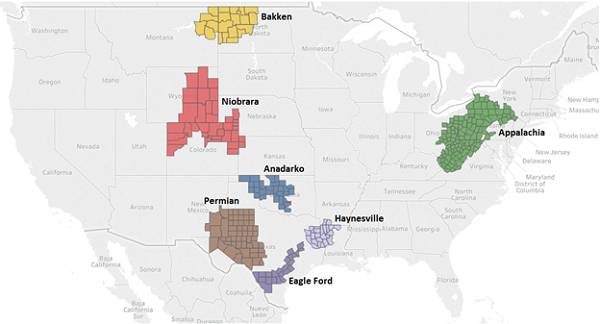
EIA Drilling Productivity Report Update – Mar ’20
According to the EIA’s March Drilling Productivity Report, U.S. oil output is expected to continue to increase through April. The Drilling Productivity Report uses recent data on the total number of drilling rigs in operation, estimates of drilling productivity, and estimated changes in production from existing wells to provide estimated changes in oil production for the seven key regions shown below.
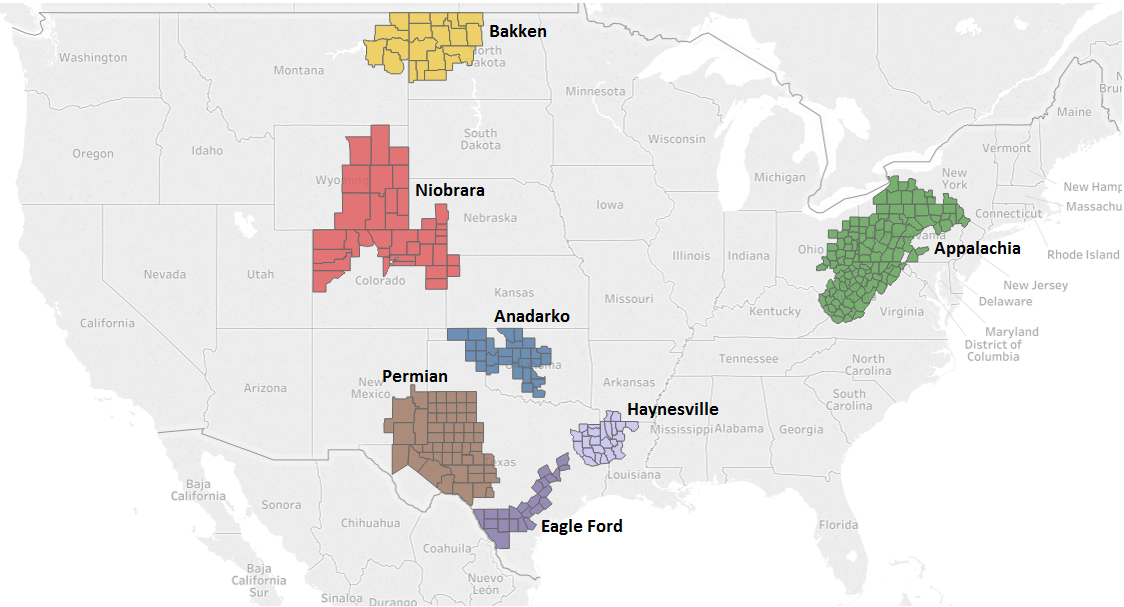 Mar ’20 production levels were revised 117,000 barrels per day (bpd), or 1.3%, below levels previously forecasted but finished 8,000 bpd, or 0.1%, above Feb ’20 production levels. Apr ’20 production levels are expected to increase an additional 17,000 bpd, or 0.2%, from the Mar ’20 revised production levels to 9.07 million bpd, finishing at the highest figure on record. Apr ’20 production forecasts are expected to finish higher on a YOY basis for the 38th consecutive month, up 8.8% from the previous year levels. The Apr ’20 YOY increase in projected production levels was the smallest experienced throughout the past 34 months on a percentage basis.
Mar ’20 production levels were revised 117,000 barrels per day (bpd), or 1.3%, below levels previously forecasted but finished 8,000 bpd, or 0.1%, above Feb ’20 production levels. Apr ’20 production levels are expected to increase an additional 17,000 bpd, or 0.2%, from the Mar ’20 revised production levels to 9.07 million bpd, finishing at the highest figure on record. Apr ’20 production forecasts are expected to finish higher on a YOY basis for the 38th consecutive month, up 8.8% from the previous year levels. The Apr ’20 YOY increase in projected production levels was the smallest experienced throughout the past 34 months on a percentage basis.
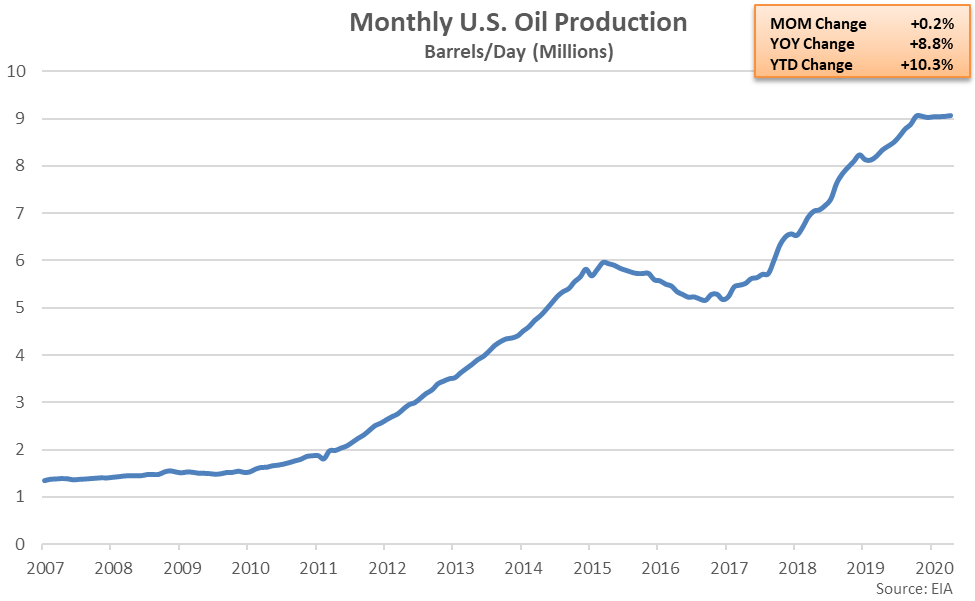 The Apr ’20 projected month-over-month increase in oil production would be the 35th experienced throughout the past 40 months, however oil production growth has decelerated over the past several months.
The Apr ’20 projected month-over-month increase in oil production would be the 35th experienced throughout the past 40 months, however oil production growth has decelerated over the past several months.
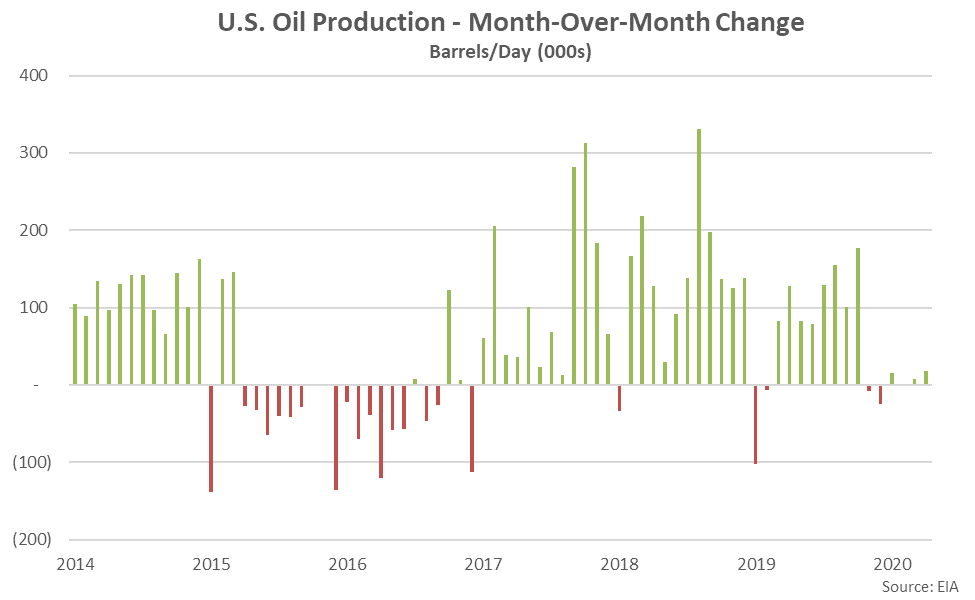 Oil production is expected to remain particularly strong within the Permian region, increasing by 0.8% on a MOM basis and more than offsetting a 0.5% MOM decline in expected oil production throughout the six other key regions.
Oil production is expected to remain particularly strong within the Permian region, increasing by 0.8% on a MOM basis and more than offsetting a 0.5% MOM decline in expected oil production throughout the six other key regions.
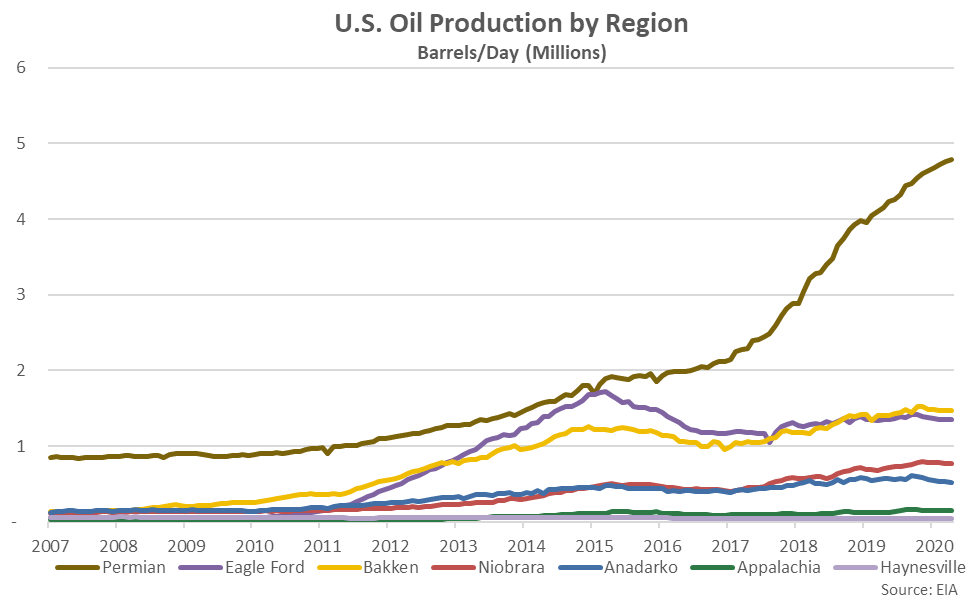 U.S. drilled-but-uncompleted (DUC) wells continued to decline from the May ’19 record highs, however, finishing lower for the ninth consecutive month. DUC wells, which have been drilled by producers but have not yet been made ready for production, have been compiled since Dec ’13. The Feb ’20 DUC wells figure of 7,637 finished 0.8% below the previous month, reaching a 15 month low level. The decline in DUC wells was the second smallest experienced throughout the past nine months, however.
U.S. drilled-but-uncompleted (DUC) wells continued to decline from the May ’19 record highs, however, finishing lower for the ninth consecutive month. DUC wells, which have been drilled by producers but have not yet been made ready for production, have been compiled since Dec ’13. The Feb ’20 DUC wells figure of 7,637 finished 0.8% below the previous month, reaching a 15 month low level. The decline in DUC wells was the second smallest experienced throughout the past nine months, however.
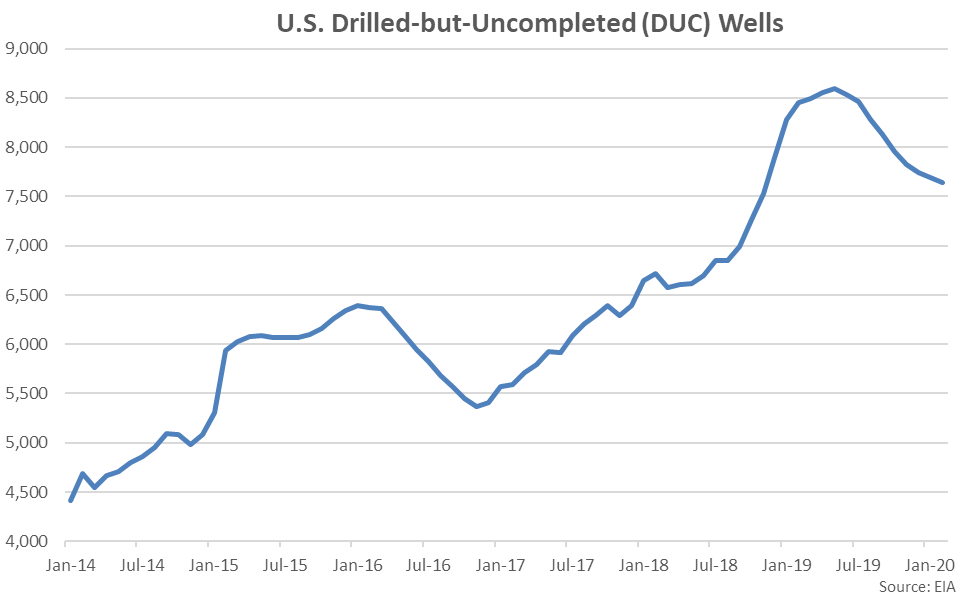 Anadarko DUC wells declined most significantly from the previous month, accounting for over 85% of the total month-over-month decline experienced throughout the seven production regions.
Anadarko DUC wells declined most significantly from the previous month, accounting for over 85% of the total month-over-month decline experienced throughout the seven production regions.
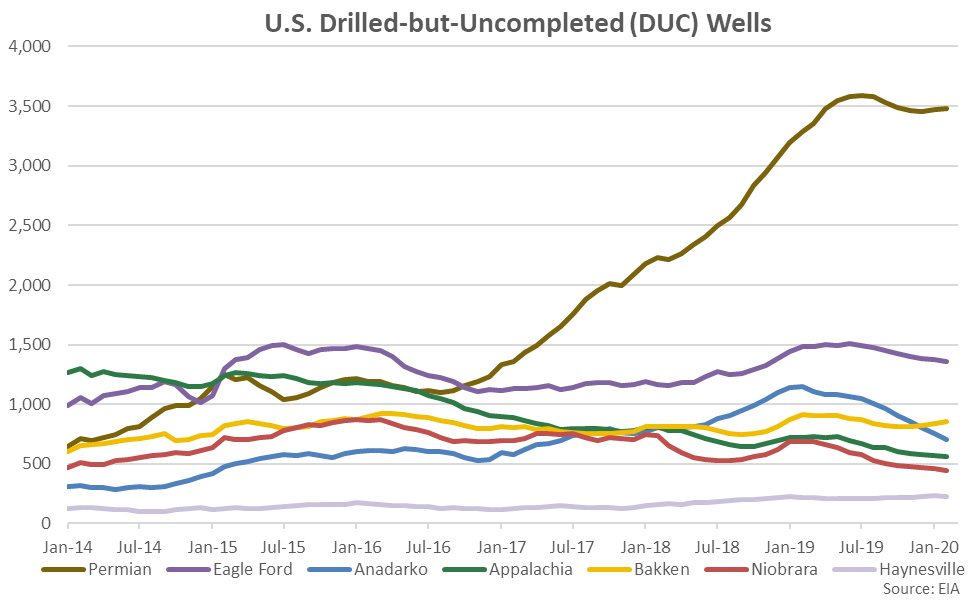
 Mar ’20 production levels were revised 117,000 barrels per day (bpd), or 1.3%, below levels previously forecasted but finished 8,000 bpd, or 0.1%, above Feb ’20 production levels. Apr ’20 production levels are expected to increase an additional 17,000 bpd, or 0.2%, from the Mar ’20 revised production levels to 9.07 million bpd, finishing at the highest figure on record. Apr ’20 production forecasts are expected to finish higher on a YOY basis for the 38th consecutive month, up 8.8% from the previous year levels. The Apr ’20 YOY increase in projected production levels was the smallest experienced throughout the past 34 months on a percentage basis.
Mar ’20 production levels were revised 117,000 barrels per day (bpd), or 1.3%, below levels previously forecasted but finished 8,000 bpd, or 0.1%, above Feb ’20 production levels. Apr ’20 production levels are expected to increase an additional 17,000 bpd, or 0.2%, from the Mar ’20 revised production levels to 9.07 million bpd, finishing at the highest figure on record. Apr ’20 production forecasts are expected to finish higher on a YOY basis for the 38th consecutive month, up 8.8% from the previous year levels. The Apr ’20 YOY increase in projected production levels was the smallest experienced throughout the past 34 months on a percentage basis.
 The Apr ’20 projected month-over-month increase in oil production would be the 35th experienced throughout the past 40 months, however oil production growth has decelerated over the past several months.
The Apr ’20 projected month-over-month increase in oil production would be the 35th experienced throughout the past 40 months, however oil production growth has decelerated over the past several months.
 Oil production is expected to remain particularly strong within the Permian region, increasing by 0.8% on a MOM basis and more than offsetting a 0.5% MOM decline in expected oil production throughout the six other key regions.
Oil production is expected to remain particularly strong within the Permian region, increasing by 0.8% on a MOM basis and more than offsetting a 0.5% MOM decline in expected oil production throughout the six other key regions.
 U.S. drilled-but-uncompleted (DUC) wells continued to decline from the May ’19 record highs, however, finishing lower for the ninth consecutive month. DUC wells, which have been drilled by producers but have not yet been made ready for production, have been compiled since Dec ’13. The Feb ’20 DUC wells figure of 7,637 finished 0.8% below the previous month, reaching a 15 month low level. The decline in DUC wells was the second smallest experienced throughout the past nine months, however.
U.S. drilled-but-uncompleted (DUC) wells continued to decline from the May ’19 record highs, however, finishing lower for the ninth consecutive month. DUC wells, which have been drilled by producers but have not yet been made ready for production, have been compiled since Dec ’13. The Feb ’20 DUC wells figure of 7,637 finished 0.8% below the previous month, reaching a 15 month low level. The decline in DUC wells was the second smallest experienced throughout the past nine months, however.
 Anadarko DUC wells declined most significantly from the previous month, accounting for over 85% of the total month-over-month decline experienced throughout the seven production regions.
Anadarko DUC wells declined most significantly from the previous month, accounting for over 85% of the total month-over-month decline experienced throughout the seven production regions.
